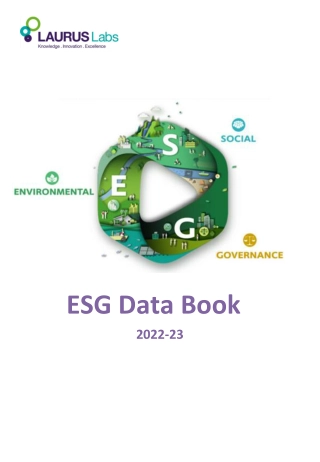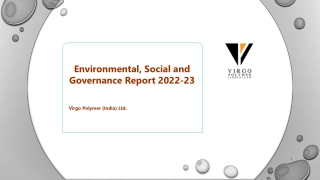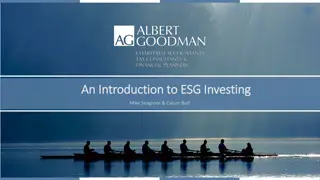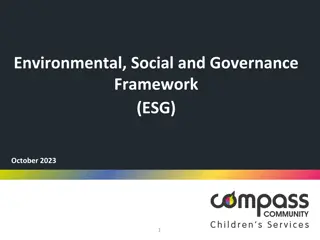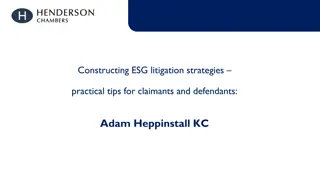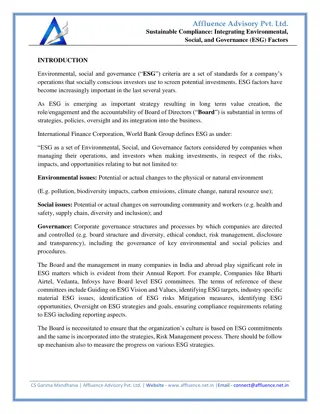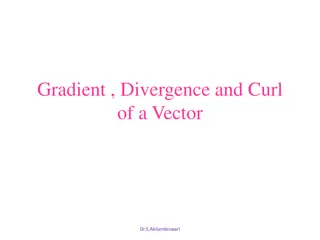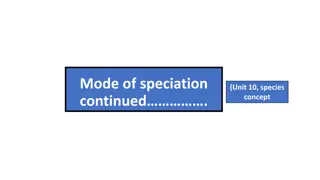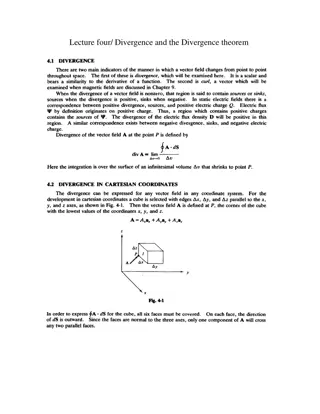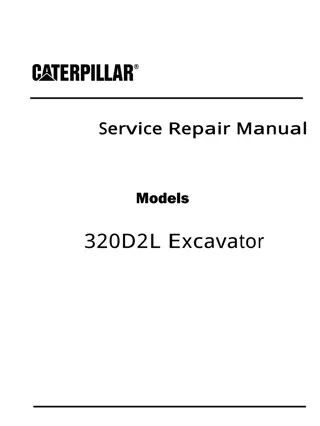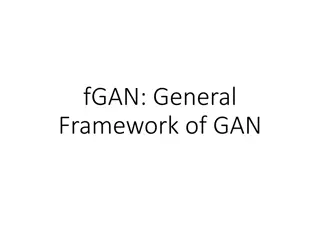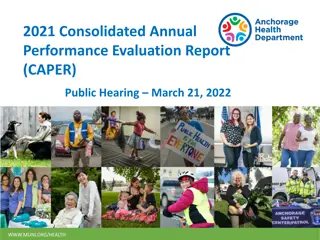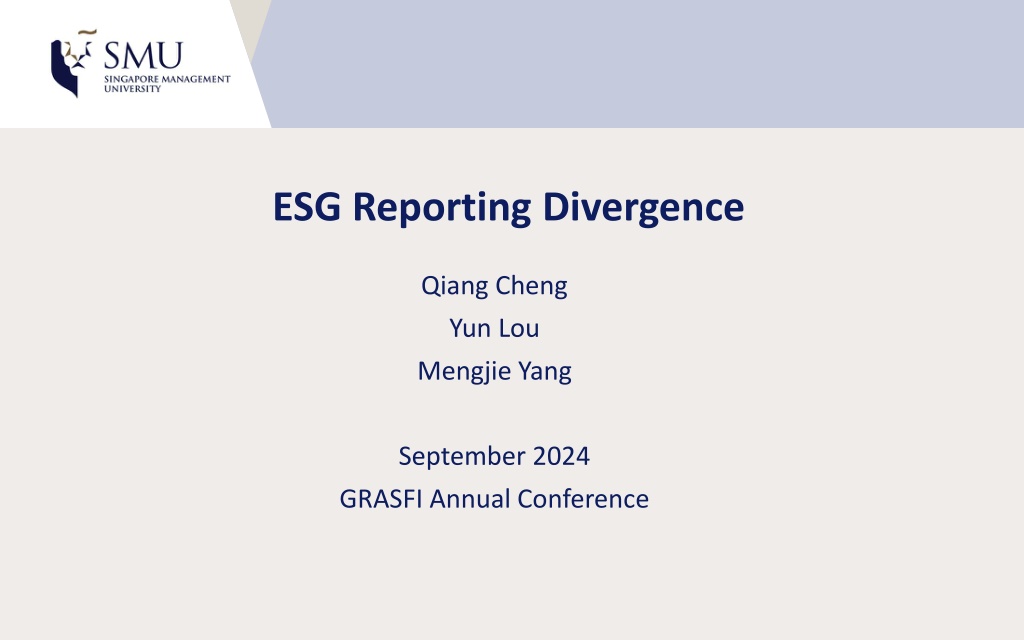
Understanding ESG Reporting Divergence and Its Impact
This research delves into the discrepancies in ESG reporting among companies, the impact on ESG ratings, mutual funds, and stakeholders, and the challenges it poses for ESG investing and decision-making processes. The study explores the implications of ESG reporting divergence on rating disagreement, mutual fund asset allocation decisions, and information processing costs for ESG rating providers.
Download Presentation

Please find below an Image/Link to download the presentation.
The content on the website is provided AS IS for your information and personal use only. It may not be sold, licensed, or shared on other websites without obtaining consent from the author. If you encounter any issues during the download, it is possible that the publisher has removed the file from their server.
You are allowed to download the files provided on this website for personal or commercial use, subject to the condition that they are used lawfully. All files are the property of their respective owners.
The content on the website is provided AS IS for your information and personal use only. It may not be sold, licensed, or shared on other websites without obtaining consent from the author.
E N D
Presentation Transcript
ESG Reporting Divergence Qiang Cheng Yun Lou Mengjie Yang September 2024 GRASFI Annual Conference
SMU Classification: Restricted Motivation Corporate accountability requires ESG information. ESG reporting is voluntary in the U.S. 70% of Russel 1000 firms reported on ESG activities in 2020 Some follow frameworks, but others do not The frameworks followed by companies vary: GRI (59%), SASB (45%), TCFD (23%) Information is not comparable across firms, which has impeded ESG investing (the 2017 CFO Institute survey). 2
SMU Classification: Restricted Examples of Difference in ESG reporting Field_Description Nitrogen Oxide Emissions Climate Change Policy Risks of Climate Change Discussed Number of Significant Environmental Fines Amount of Significant Environmental Fines Renewable Energy Use Water Consumption Quality Assurance and Recall Policy Gender Pay Gap Breakout % Disabled in Workforce Fatalities - Total Employee Turnover % Total Hours Spent by Firm - Employee Training Employee CSR Training Advanced Micro (i) Intel (j) 0 0 0 1 1 1 0 0 0 0 0 1 0 0 1 1 1 0 0 0 1 1 1 1 1 0 1 1 3
SMU Classification: Restricted Research Objective To investigate the adverse consequences of ESG reporting divergence for users ESG rating providers Does ESG reporting divergence affect ESG rating disagreement? ESG mutual fund Does ESG reporting divergence affect ESG fund allocation with respect to firms ESG performance? 4
SMU Classification: Restricted Predictions ESG rating providers: Costs of information processing (of focal and comparable firms ESG) For ESG rating providers The reliance on public ESG information The reliance on private information H1: Ceteris paribus, ESG reporting divergence is positively associated with ESG rating disagreement. 5
SMU Classification: Restricted Predictions ESG mutual funds They rely on ESG ratings and ESG information to make asset allocation decisions (Avramov et al. 2022). Firms with better ESG performance attract ESG fund (Hartzmark and Sussman 2019). ESG reporting divergence Costs of information processing ESG funds find it more difficult to evaluate firms ESG performance. ESG funds rely less on ESG performance to allocate assets. H2: Ceteris paribus, the association between ESG ratings and ESG fund allocation is weaker for firms with high ESG reporting divergence than for firms with low ESG reporting divergence. 6
SMU Classification: Restricted Construction of ESG reporting divergence What to capture: the heterogeneity in the availability of ESG items 122 standardized ESG reporting fields collected by Bloomberg from firms ESG reports, annual reports, or websites Step 1: to construct a 122 1 vector with indicators that represent the availability of each ESG reporting item for a firm-year: ???= (???,1,???,2, ,???,121,???,122) Step 2: firm-pair-year similarity in the reporting of ESG items ??? ??? ???????? ?????????????= ??? ???+ ??? ??? ??? ??? Step 3: ESG reporting divergence at the firm-pair-year: 1 - ???????? ????????????? 7
SMU Classification: Restricted Example: Advanced Micro (i) and Intel (j) in 2020 i ji ij j Environmental reporting fields (46) Social reporting fields (46) Governance reporting fields (30) 22 19 29 25 21 29 30 30 30 Total ESG_Diverg = 1 - Tanimoto Similarity = 1 - 70 75 90 70 75+90 70 = 0.263 22 25+30 22 =0.333 19 21+30 19 = 0.406 29 29+30 29 =0.033 E_Diverg = 1- Tanimoto Similarity =1 - S_Diverg = 1- Tanimoto Similarity = 1 - G_Diverg = 1 - Tanimoto Similarity =1 - 8
SMU Classification: Restricted Validation Tests Firm i and firm j adopt the same reporting frameworks Mean 0.294 Other firm-pairs Difference -0.096 ESG_Diverg N Mean 0.390 N Mean p-value 23,227 412,954 0.001 Firm i and firm j in the same extreme firm size quintile Firm i and firm j in the opposite extreme firm size quintile Mean 0.387 Difference ESG_Diverg Mean 0.254 N N Mean -0.133 p-value 0.001 165,734 98,800 Firm i and firm j in the same extreme ESG performance quintile Firm i and firm j in the opposite extreme ESG performance quintile Mean 0.368 Difference -0.117 ESG_Diverg Mean 0.251 N N Mean p-value 106,232 65,739 0.001 9
SMU Classification: Restricted Construction of ESG Reporting Divergence (cont d) Step 4: ESG reporting divergence at the firm-year: ???_???????? The mean of the ESG reporting divergence for each firm ? ? pair for all of the other ? firms in the same industry (i.e., other than firm i) in year ?. SASB s Sustainable Industry Classification System (SICS) Variables ESG_Diverg E_Diverg S_Diverg G_Diverg N Mean 0.316 0.916 0.600 0.095 Std. Dev. 0.118 0.105 0.161 0.051 P25 0.222 0.863 0.478 0.064 Median 0.295 0.957 0.583 0.085 P75 0.401 1.000 0.715 0.108 14,927 14,927 14,927 14,927 10
SMU Classification: Restricted Main Tests of H1 ESG Rating Disagreement (1) 2.810** (2.10) E Rating Disagreement (2) 13.029*** (6.94) Yes Yes Yes S Rating Disagreement (3) 2.329*** (2.77) Yes Yes Yes G Rating Disagreement (4) 7.519*** (2.99) Yes Yes Yes Dependent variable ESG_Diverg H1 + + + + E_Diverg S_Diverg G_Diverg Control variables Year FE Industry FE ESG Rater Combination FE N Adj. R2 Yes Yes Yes Yes Yes Yes Yes 14,927 0.169 14,927 0.403 14,927 0.210 14,927 0.113 A relative increase of 2.4% (6.4%, 2.5%, 2.7%) from sample mean for ESG (E, S, G) reporting divergence. 11
SMU Classification: Restricted Main Tests of H2 Dependent variable ESG_Rating A relative decrease of 32.6% (24.5%, 51.2%, 7.6%) from sample mean for ESG (E, S, G) reporting divergence. ESG Fund Holding (2) H2 (1) (3) (4) 0.092*** (7.15) -0.254*** (-2.72) ESG_Diverg ESG_Rating 0.079*** (5.23) -0.164* (-1.69) E_Rating E_Diverg E_Rating 0.056*** (4.47) -0.243*** (-3.91) S_Rating S_Diverg S_Rating 0.034** (2.36) -0.022 (-0.10) Yes Yes Yes Yes 12,573 0.187 G_Rating G_Diverg G_Rating Control variables Year FE Industry FE ESG Rater Combination FE N Adj. R2 Yes Yes Yes Yes 12,573 0.198 Yes Yes Yes Yes 12,573 0.196 Yes Yes Yes Yes 12,573 0.190 12
SMU Classification: Restricted Sensitivity Tests Alternative measures of reporting divergence: TNIC industry classification SASB materiality items Use firm fixed effects No differential effects across high and low ESG disclosure subsamples 13
SMU Classification: Restricted Additional Test: Spillover Effect of EU Regulation European Union (EU) passed Directive 2014/95 public-interest entities in the EU with more than 500 employees to prepare annual nonfinancial reports (i.e., ESG reports) from fiscal year 2017. The objective: to increase the relevance, consistency and comparability of ESG reporting among the EU firms. This applies to US firms subsidiaries in the EU Potential effect on US parent firms ESG reporting divergence among industries with a high proportion of firms with subsidiaries in the EU (treatment firms) ESG rating disagreement ESG fund allocation with respect to ESG performance 14
SMU Classification: Restricted Additional Test: Spillover Effect of EU Regulation Panel A: Panel B: 15
SMU Classification: Restricted Contributions This is the first paper that provides systematic evidence on ESG reporting divergence among US firms. This paper contributes to the literature ESG rating disagreement: ESG reporting divergence is an important determinant Comparability: this paper extends the literature from financial reporting comparability to non-financial information comparability The paper provides suggestive evidence on the potential effect of the SEC proposals on climate risk and ISSB proposals on sustainability reporting. 16

